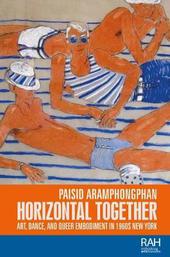
|
Horizontal Together: Art, Dance, and Queer Embodiment in 1960s New York
Hardback
Main Details
| Title |
Horizontal Together: Art, Dance, and Queer Embodiment in 1960s New York
|
| Authors and Contributors |
By (author) Paisid Aramphongphan
|
| Series | Rethinking Art's Histories |
|---|
| Physical Properties |
| Format:Hardback | | Pages:208 | | Dimensions(mm): Height 234,Width 156 |
|
| Category/Genre | Art and design styles - from c 1960 to now
Performance art
Contemporary dance |
|---|
| ISBN/Barcode |
9781526148438
|
| Classifications | Dewey:700.866 |
|---|
| Audience | |
|---|
| Illustrations |
12 colour illustrations, 44 black & white illustrations
|
|
Publishing Details |
| Publisher |
Manchester University Press
|
| Imprint |
Manchester University Press
|
| Publication Date |
4 May 2021 |
| Publication Country |
United Kingdom
|
Description
Horizontal Together tells the story of 1960s art and queer culture in New York through the overlapping circles of Andy Warhol, underground filmmaker Jack Smith and experimental dance star Fred Herko. Taking a pioneering approach to this intersecting cultural milieu, the book uses a unique methodology that draws on queer theory, dance studies and the analysis of movement, deportment and gesture to look anew at familiar artists and artworks, but also to bring to light queer artistic figures' key cultural contributions to the 1960s New York art world. Illustrated with rarely published images and written in clear and fluid prose, Horizontal together will appeal to specialists and general readers interested in the study of modern and contemporary art, dance and queer history.
Author Biography
Paisid Aramphongphan is an independent scholar. He holds a PhD in the History of Art and Architecture from Harvard University and is a winner of the Terra Foundation International Essay Prize. -- .
Reviews'Paisid Aramphongphan brings together theories of dance, queer studies, and fine art to lay a glittering tapestry of connection and conversation across the practitioners of the period... Horizontal together is a hopeful work that offers new insight and critique in the service of a more inclusive historical practice.' Fen Kennedy, Dance Research Journal -- .
|